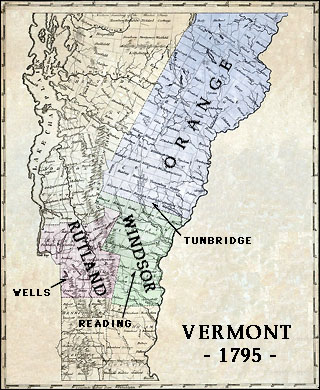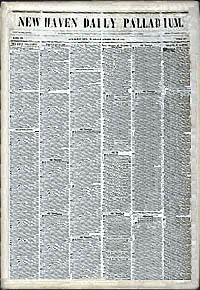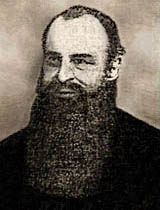
READINGS IN EARLY MORMON HISTORY
(Newspapers of New England)
Misc. New England Newspapers
1880-1930 Articles

1800-1829 | 1830-1839 | 1840-1844 | 1845-1879 | 1880-1930
Newspaper Articles Index | Maine Newspapers
Vol. ? Boston, Mass., Monday, April 18, 1881. No. ?
MORMON MYSTERIES.
Our telegraphic columns told the story recently of Miss Caroline Owens, the second wife of John Miles, the Mormon, by whom she was lured from England to Salt Lake and induced to become his wife on the pretence that he had no other. After the ceremony, nevertheless, she was introduced to one Emily Spencer as her husband's first wife, in consequence of which revelation she lived a life of misery and torture. In the Chicago Inter-Ocean she thus describes the scenes that were enacted in the Endowment House on the day of her marriage: |
Vol. XLI. New Haven, Conn., Monday, December 19, 1881. No. 292.
Now that methods for the rooting out of Mormonism are being warmly agitated, the manner In which the sect originated becomes of interest. Mr. Joseph Miller, who has reached the advanced age of 92 years and lives at Ten Mile, O., [sic] declares that the Rev. Solomon Spaulding, now deceased, was the author of the "Book of Mormon." Mr. Spaulding, who was an enthusiastic archaeologist, was of the opinion that the American continent was at one time peopled by a colony of ancient Israelltes and that this colony were the progenitors of the "mound-builders." Imbued with this idea, he wrote a fictitious history of the ancient race, under the titIe of the "Lost Manuscript Found," and originally intended it for publication but finaIly gave up the idea. This was about the year 1812. Joseph Smith, the founder of the Mormon sect, in some way came in possession of the manuscript of Mr. Spaulding's novel and, changing the title and making some emendations, attempted to palm it off upon the public as having been discovered by him in some mysterious manner, claiming it to be a revelation from God. That the book was a clumsy forgery on the part of Smith has been tbe common belief, but that it was stolen rather than forged, as is asserted by Mr. Mills is an entirely fresh version, of the origin of lhe celebrated "Book of Mormon." |
 Vol. ? Boston, Mass., Wednesday, November 19, 1884. No. ?
For the Boston Investigator.
MR. EDITOR: -- The INVESTIGATOR, like Col. Ingersoll, strenuously defends monogamy, and as zealously opposes polygamy. The sanctity and purity of marriage have no more earnest supporters and defenders than the Editor of the Investigator and Col. Ingersoll. The former has exemplified this in his controversy with a citizen of the Golden State, in some of the late issues of the Investigator. |
Vol. ? Boston, Mass., January 8?, 1885. No. ?
MORMONISM IN A NEW LIGHT. The origin of Mormonism has been read by the world through the Spaulding romance and Anthon letter spectacles, which revealed fraud and imposture only, proving Smith and his followers knaves or fools; and yet I believe the verdict of history will be that the Spaulding manuscript never fell under the eyes of Smith, while the characters from the plates did fall under the eyes of Prof. Anthon. Still, the cry of "Fraud! fraud!" is heard on every hand, from reputable authors and liberal editors no less than from venal and bigoted writers. It is hard for the world to admit it has borne false witness against the Mormons, and that, in its attempt to put down Mormonism, it has told more lies about it than it was charged with telling about itself. But what a different complexion is given to the argument, if the Book of Mormon was not taken from the Spaulding manuscript... |
Vol. ? Boston, Mass., Thurs., May 21, 1885. No. ?
CORRESPONDENCE. Editors of The Index: -- |
Vol. XXXVII. Boston, Thursday, May 21, 1885. No. 21. NEW LIGHT ON MORMONISM. This volume, by Mrs. Ellen E. Dickinson, contains a clear and readable account of the origin and growth of Mormonism. It is a timely and important book, in writing which the author has had peculiar facilities due to her being a relative of Rev. Solomon Spaulding, the author of the romance, The Manuscript Found, upon which -- it having been stolen -- the so-called Book of Mormon was based. Mrs. Dickinson gives helpful recollections of Mr. Spaulding's character and of his book, describes the manner in which Joseph Smith, Sidney Rigdon, and others formed their conspiracy, traces the rise and progress of the Mormon body, follows it in its wanderings and settlements in Missouri and Illinois to its establishment in Utah, sets forth the peculiarities of the system, insists upon its treasonable and subversive attitude towards our national Government, distinguishes between the Utah Mormons and the Josephites, or non-polygamous Mormons, many of whom live in New England, and, in general, presents a comprehensive, spirited and valuable study of the subject. |
Vol. XXXVII. Boston, Thursday, July 30, 1885. No. 31.
WHO WROTE THE BOOK OF MORMON? Just how many inquiries have come to Honolulu in regard to a manuscript in the possession of Mr. L. L. Rice, who came from Ohio to this city in 1879, to reside with his daughter, Mrs. J. M. Whitney. Mr. Rice was at one time editor of the Painesville (O.) Telegraph, having in connection with his partner, Mr. P. Winchester, in 1839 bought that newspaper, with all the appurtenances of the printing office in connection with it, from Mr. Eber D. Howe, the former proprietor, In the mass of material turned over to Mr. Rice was a small parcel that was labeled in pencil "Manuscript Story -- Conneaut Creek." The parcel never had been opened till last summer, when Mr. Rice was looking over his papers, in search of memorabilia, in regard to the early anti-slavery movements in Ohio, in which he had actively engaged. He then found that it was the story written by Rev. Solomon Spaulding who, it has been claimed, wrote the "Book of Mormon," which Joseph Smith, Jr. published as an inspired translation of certain records, in regard to the American Indians and their connection with Christianity, engraved on golden plates, and found by him on the top of a hill in Palmyra, N.Y. In the rubbish of a printing office that manuscript of Mr. Spaulding's for which diligent search has hitherto been made in vain, has been as effectually lost as if it had been entombed in some forgotten Indian burial cave, to be strangely resurrected in these islands in the Pacific Ocean. |
Vol. XVII. Boston, Mass., April 3, 1886. No. 7.
CORRESPONDENCE.
To the Editor of the Literary World: |
 Vol. ? Springfield, Tuesday, October 18, 1887. No. ?
THE BEGINNINGS OF MORMONISM.
Happening to be placed in a position where I became acquainted with Mormonism in its inception. I have frequently referred to its incidents, more or less fully among friends, and have often been solicited to write out my recollection of the events of that time. I was then at an age when such occurrences make lasting impressions, and especially so, if it is claimed that there is something supernatural about the matter. As the years increase and the Mormon institution has grown to its present proportions, I have thought it might interest the people of to-day to know something of its beginnings, from one who had abundant opportunities to observe what was going on, even if he lacked in judgment to estimate its character or speculate as to its results. |
|
Vol. 83. Montpelier, Vermont, Wed., October 26, 1887. No. 3.
The Book of Mormon. J. F. Peck, who became acquainted with Mormon in its inception, furnishes the following account of the finding of the "Mormon Bible" to the Springfield Republican: |
Maine articles have been moved to a new location
Vol. ? St. Albans, Vermont, March 31, 1897. No. ?
VERMONT MORMONS' HOME.
The proposition of the people of Utah to place a statue of Brigham Young in the statuary hall at Washington as a representative citizen of that state brings to mind the fact that the president of the Mormon republic is numbered among the famous sons of Vermont. |
Vol. ? Boston, Mass., July 18, 1897. No. ?
The Book of Mormon The appearance of the Book of Mormon awakens in the memory of certain persons, who heard chapters read by the author of a work called the Manuscript Found, and detected an extraordinary resemblance between the two. |
|
Vol. ? Hartford, Conn., Friday, October 8, 1897. No. ?
BOOK OF MORMON.
The Mormon church was the topic of the Rev. Dr. E. P. Parker in the chapel of the South Congregational Church last evening. The three New England men, Joseph Smith and Brigham Young, natives of Vermont, and to Solomon Spaulding, who was born in Ashford in this state, the Mormon church is greatly indebted; Vermont having provided its organization and working force, and the Connecticut man furnishing the brains of its literature. |
Vol. XVI. Portsmouth, N. H., Monday, January 8, 1900. No. 4662.
LATTER DAY SAINTS.
Joseph Smith, the founder of Mormonism, was born in Sharon, Vermont, 1805. His mother was a superstitious fortune teller. His father was illiterate, indolent and intemperate. The boy was raised with bad environments, without the advantage of an education. At 15 years of age in an exciting revival he professed conversion and began at once to claim that he saw visions, that Peter. James and John appeared to him with revelations from heaven. There was in him a strange mixture of religious emotion and base immoralities. |
Vol. ? Springfield, Thursday, May 31, 1900. No. ?
DEATH OF DR. MCKINSTRY.
Dr. John A. McKinstry, 69, died this morning between 5 and 6 o'clock, in his home in Longmeadow. He was born in Monson, his parents being Dr. John McKinstry and Matilda Spaulding McKinstry. His father was of Scotch descent, and his mother was the daughter of Rev. Solomon Spaulding, who is believed to have been the author of the Book of Mormon. He wrote it as a story, and left it among some papers in Western New York, and it is believed that it was stolen by Joseph Smith, the founder of Mormonism, and given as a revelation from heaven. |
 Vol. ? Springfield, Friday, June 1, 1900. No. ?
LONGMEADOW DOCTOR'S DEATH.
Dr. J. A. McKinstry died at his home in Longmeadow at 6 o'clock yesterday morning, after a long period of nerve debility and physical weakness. He gave up his practice about two years ago, but was able to be about the house until within a few days of his death, which was hastened by heart failure. Dr. McKinstry in appearance was rather tall and of a striking figure and the above picture represents him as he is remembered when in active practice some years ago. His family is of Scotch descent. John McKinstry, the first of the name to come to this country, was graduated from the university of Edinburg in 1712, and settled near Boston as a Presbyterian minister. In 1733 he removed to Ellington, Cr., and there his descendant, Oliver, the father of Dr. McKinstry, was born in 1791. After practicing some years in Connecticut, Dr. Oliver McKinstry moved to Monson, where he married Matilda, the daughter of Rev. Samuel [sic] Spaulding, the author of a historical romance entitled, "Manuscript Found," from which it is believed the Mormons stole the greater part of their Bible. John Alexander was the second son of Dr. Oliver McKinstry. He attended the schools and academy of Monson, and studied with his father and also with Dr. Alvin Smith of Monson and Dr. Davis of Three Rivers. His medical education was then continued at the Albany medical college, from which he was graduated in 1853. The following four years he practiced in the states of New York and Wisconsin. In 1857 he located in Coventry, Ct., but after the death of Dr. Cady of Monson in 1861, he complied with an earnest request to return to Monson, where he practiced for seven years, when an inherited tendency to lung trouble decided him to give up his practice, and two years were spent on the Maryland coast. His health being much improved, he returned North and for three years was located on Armory hill in this city, when his health for the second time becoming impaired, he went to his sister's in Washington, D. C., and accepted the position of medical examiner for the pension bureau, where he served four years, traveling through the South and West. |
|
Vol. ? Boston, Mass., Sunday, September 11, 1904. No. ?
WHEN A MORMON RAN
Did you know that Joe Smith, the Mormon prophet, was a candidate for President of the United States just 60 years ago? And that there was a rally held in his interest right here in Boston? And that Brigham Young himself was the spellbinder on that occasion? ... |
 Vol. ? Springfield, Sunday, June 21, 1908. No. ?
THE BOOK OF MORMON.
A new edition of "The Book of Mormon" [has been published]... so much for the origin of the book... [several lines missing from clipping] |
 Vol. ? Springfield, Saturday, June 27, 1908. No. ? THE BOOK OF MORMON. To the Editor of the Republican: -- |
 Vol. ? Springfield, Sunday, November 10, 1910. No. ?
VERMONT MORMON ORIGINS.
Hidden treasure and strange prophecies are the springs of the great stream of Mormonism that is to-day breaking its banks and penetrating into every part of the world. The story goes like this, if we accept the account of an old booklet limited in circulation and nearly forgotten. The prenatal cause of the movement commenced with a trouble maker named Nathaniel Wood. Wood was a preacher who moved to Middletown, Vt., and when the Congregational church was built there, offered his services as minister. He was rejected and later dismissed from the church because he tried to "upset things." Wood was a determined man and hated to be defeated, so he established meetings of his owb and soon had quite a congregation. His favorite theme was on the judgments of God. "He regarded himself and his followers as modern Israelites or Jews, under the special care of Providence; that the Almighty would not only specially interpose in their behalf, but would visit their enemies, the Gentiles (all outsiders), with his wrath and vengeance." |
 Vol. ? Springfield, Sunday, Sept. 13, 1925. No. ?
RECENT MORMON TALK RECALLS
Rutland, Vt., Sept. 12 -- The town of MiddletownSprings in this county was the scene of the prculiar "Woods scrape." as it was called, which occurred in 1800, and is considered by several authorities as the real beginning of Mormonism in Vermont; this state also being the birthplace of both Joseph Smith and Brigham Young. |
|
Vol. ? Hartford, Conn., Sunday, January 3, 1926. No. ?
CONNECTICUT'S PART IN MORMONISM
If Brigham Young lived in the present age of bobbed hair and powdered faces and short skirts would he have stopped at thirty wives? After looking over the girls at Salt Lake City Mark Twain placed Brigham Young in the role of a [liberator], the doer of a "deed of open handed generosity, so sublime nations should stand uncovered in his presence and worship in silence." Life was just one wedding tour [after] another for the much married gentleman from Utah, a life in which Connecticut played an important part, for in this state was born the author of the "Mormon Bible," and one of Young's ablest cabinet ministers. We know that the "Book of Mormon" had for its foundation "Manuscript Found," a fanciful romance written purely and simply as an entertaining story, as an outlet for such thoughts as [man] may have, by an ardent Congregational minister, [pIagiarized] by Apostle Joseph Smith and Sidney Rigdon, another of the original twelve [sic], it became a vehicle for the rise of a new religion, a source of grief for all related to its author. That "Manuscript Found" had been stolen for use as Apostle Smith's Book of Mormon was not discovered until publication of the "Golden Bible." And not only did the worthy apostle steal his material, but also did he go so far as to charge that "some person or persons have stolen and kept from me, notwithstanding my utmost to recover again" the original document. |
|
Vol. ? Hartford, Conn., Tuesday, July 30, 1929. No. ? THE BOOK OF MORMON ... [Seeing] that a lecture upon the Book of Mormon was recently given in Hartford prompts me to send you this extract from the "History of Windham County" printed in 1889, as being of interest: -- "Rev. Solomon Spauldlng was born in Eastford, educated at Dartmouth College and preached in Western New York. When out of health for his diversion he wrote a legendary story of the Indians, which is supposed to have furnished the basis of the Book of Mormon. His brother Josiah, who was with him when he wrote the legendary tale and heard him read his manuscript, said it was so similar that, when he read the Mormon Bible he usually knew what was to come before he read the pages. Rigdon, an elder afterward high in office, borrowed the manuscript of the widow under the alleged purpose of using it to refute Mormonism, but would never return it to its owner."... |
Back to top of this page.
Articles Page | Articles Index | History Vault
Oliver's Bookshelf | Spalding Library | Mormon Classics
last updated: Aug. 2, 2012

